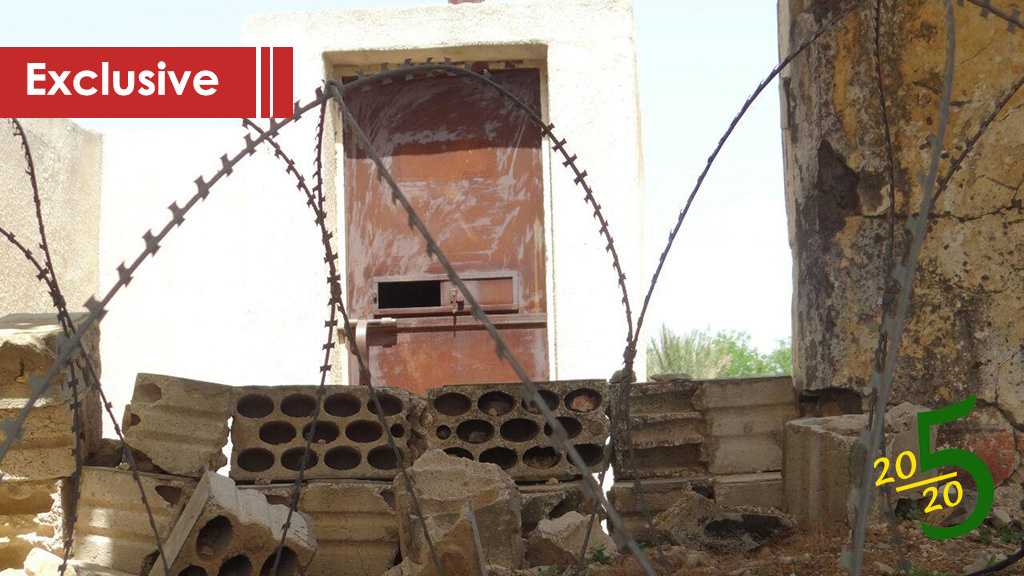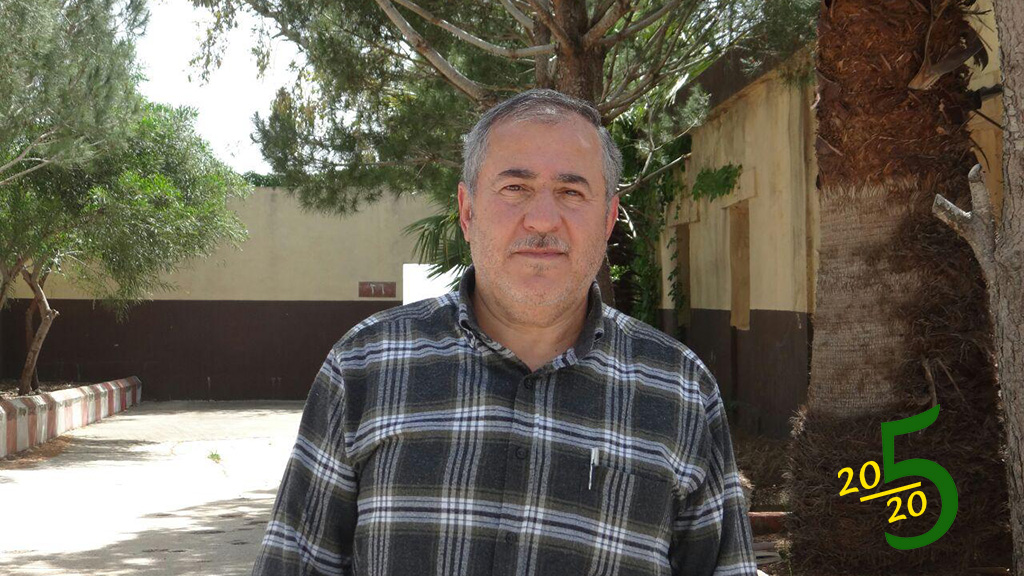
Eleven Years in the Dark Corridors of the Khiam Detention Center: An Unbreakable Will to Resist

By Zeinab Abdallah
South Lebanon - It has been a couple of decades since Lebanon was liberated from the ‘Israeli’ occupation. It is a 20-year old achievement that is being strengthened at every turning point.
Only children didn’t know, at the time, the true stories of pain behind the joy this event has brought to their lives, the ones who were used not to have a single place where they could spend their summer vacations.
What will be narrated below is just the story of one person. A southerner who decided to stand up against the occupation of his country. This person ended up spending 11 years behind ‘Israeli’ bars from November, 1985 until July, 1996.
Liberated detainee Hajj Ali Khsheish, who has the scars of those 11 years on his body and soul, told al-Ahed News about how he was detained, torture inside the prison, and the inhumane treatment of ‘Israeli’ collaborators.

“In the beginning, we had a resistance activity inside an occupied area where the ‘Israeli’ was very comfortable to practice whatever he wants. It was a group of youngsters who decided to resist the occupier and hence we founded a small group that was known the Islamic Resistance.”
The early resistance men, he added, were under the ‘Israeli’ agents’ sight. For them, it was both difficult and dangerous to transfer a weapon inside the occupied territories. That’s why at the time, many arrests were made in the village of Khiam and other villages in the region. Members of different political organizations were also detained.
On November 11, 1985, Hajj Ali, as well as many other members of the Islamic Resistance were detained and taken to the Khiam Prison, better known as the Khiam Detention Center, which was located in Hajj Ali’s own homeland, and run by Antoine Lahd’s militia under the ‘Israeli’ administration.
Interrogation and torture
Interrogation was as harsh as all forms of torture practiced inside the place. The enemy, according to Hajj Ali, doesn’t spare an area in the human body un-tortured to obtain the information he wants. ‘Israel’ was dying to learn all information related to the resistance activities and how it is transferring weapons and exchanging information.
According to his own experience, Hajj Ali says he had been interrogated for four months in a raw. “During the same period, many arrests from Bint Jbeil, Markaba and Taybeh were made, so the enemy assumed that there is a common link between those groups, although every group was indeed operating separately.”
In the painful memories of his years behind the ‘Israeli’ bars, the man repeats that torture was very harsh. ‘Israel’ mastered its means of torture in that place, which were numeral and inhumane at every level. Electric shocks, electric cables, electric pole hangers, deprivation of sleep, food and restrooms, head covers and handcuffs, solitary cells, the ‘Chicken Coop’, insults, intimidations and torturing relatives… and the list goes on.
“We used to sleep in corridors before being transferred to cells. At the time, the prison’s area wasn’t fit to contain the huge number of detainees. While sleeping there, the jailer walks into the corridor and kicks us. Even when we are hanged on the electric poles we were also beaten…” the man said, adding that “they used to rub our wounds with salt, or warm up an iron rod to burn parts of our bodies… all of their methods were barbaric, they didn’t use any humane action when dealing with the detainees.”
Many detainees were martyred while hanged naked, in cold and hot weathers, and without food or water, for three days on the electric poles.
Such innovated methods were both directed and supervised by Amer al-Fakhoury, the ‘Israeli’ collaborator who in a couple of months ago fled Lebanon after being discharged by the Lebanese Military Tribunal on the crimes he has committed due to the ‘passage of time’.
Torture was not limited to the period of interrogation, it would rather accompany the detainee all over his time at the prison. This depends on how moody the jailer is.
Interrogators were focused on obtaining any piece of information about Hezbollah, and the activity of the Islamic Resistance. They focused on detainees affiliated with Hezbollah, their bitterest enemy who caused them a lot of pain. Even when the Islamic Resistance carries out a successful operation, they used to retaliate by torturing the detainees.
“They didn’t treat us as humans, they didn’t take into account any health condition the detainee could be suffering from. Even for those whose hands or legs were amputated, they used to beat them on that areas.”
The post-interrogation period
After the minimum of two months interrogation period and solitary confinement, detainees were transferred to 2-meter wide and 2.5-meter long cells. They were designed for five detainees at the same time. The cells were neither equipped with light, nor with toilets. “At night, we sleep in line, everyone’s head is opposite to the other’s legs…”
The room didn’t even have a restroom inside it, detainees couldn’t but use a bucket to have their essential need met. They were not allowed to speak inside their cell, nor anywhere else. Their voice mustn’t be heard, otherwise the jailer knows what he would do. Detainees were even denied the right to sun exposure. They were only allowed for 5 minutes every month or less in a small yard that they crowd inside it 10 to 15 detainees.
“It was barely one tour inside the yard before we are taken back to our cells. Speaking was not allowed there, neither was smiling at each other.”
Food, water and medication
Every portion of food served to one detainee per day wasn’t meant to fill the stomach of a baby. Two small toasts for breakfast, with three olives and jam. Then comes the lunch, an entire dish of unsalted stew to serve the five detainees inside each cell. And finally the dinner, also two small toasts with a boiled egg and a potato.
“We considered that we are living only because the angel of death was busy somewhere else. Everything inside the Khiam Detention Center was driving us to death, and this is why when a new colleague entered the prison, he told me that my family learned that I was dead, and that they held a memorial service for me,” Hajj Ali Khsheish recalled.
The place doesn’t resemble any of the world’s prisons. The maximum period of interrogation in any jail in the world is 72 hours, then the prisoner would be moved to a cell that fits for a human use. In this case, however, there didn’t exist even the least of elements of the human survival.
Minding the portions of food prisoners were served inside the place, it was subsequently understandable that they would be dined drinking water as well.
The jailers would deprive detainees from drinking water for three consecutive days under the pretext that the water service is cut off. “We used to demand drinking, even from the water heater, which was already rust, only to quench our thirst.”
‘Miscol’ was the multifunctional drug we were given, Hajj Ali said. It was an ‘Israeli’ drug, most of the times we discover it was expired when given to us, but the jailers used to give to the detainees every time they feel a pain, no matter what kind of pain or in which body organ. Detainees, in best cases, were injected with water instead of medicine.
Freedom of religious rituals
Detainees used to recite the holy Quran according to the memorizations, they didn’t actually have access to any hard copy, although they managed once to obtain a very small part of the holy book, which they secretly shared by turn.
In Ashura, for example, when the jailer hears that they are making any activity, he used to open the cell suddenly and start beating them.
Even in the holy month of fasting, jailers turn generous and force fasting detainees to drink and eat. Indeed, they pour water inside their mouths. Once, a detainee thought he would escape a forced breakfast, so when the jailer asked him if he is fasting, the detainee said no. The jailer, however, started beating and scolding him because he is a Muslim but was not fasting!
Tyranny anytime, anywhere
“Sometimes, jailers order detainees to cover their heads, it was up to their mood if they don’t want to see our faces. The prison’s regime was arbitrary. Everybody should be awake at 6, with the components of their cell be organized. Sometimes, they storm the cell at midnight, or even after, they force detainees to stand up facing the wall, raising their hands up, for an hour or two,” Hajj Ali added.
Other times, when the wrestling team a jailer likes loses, he takes a group of detainees to the yard and starts beating them!
As a result, detainees used to organize hunger strikes to raise their voice high…
The Khiam Detention Center Uprising
“One time, the detainees rejected food for three times because a jailer dragged one of us while he was preforming prayers and took him out. Detainees started knocking the doors. How would they do such thing during the prayers?”
The uprising started in 1993, and what was remarkable is that all detainees, even the women in their separate building, united with each other, without learning the reason ahead, they just heard the knocking and understood that some major thing was going wrong.
The jailers, however, threw gas bombs and fired some shots inside the already narrow and closed prison cells. Many detainees suffocated, so the others calmed down to save the lives of their fellows. After that, the jailers took around 70 detainees outside and started beating them until the strike ended.
The prisoners’ demands were access to sufficient food as well as sun exposure and restrooms, the basic needs provided in the rights of detainees according to the Geneva Conference. The prison’s administration responded to the demands. However, it was very soon that they backtracked this policy. The ‘Israeli’ policy was keen to keep the detainees’ only concern is to have food, sun exposure and toilets. Otherwise, if things remained comfortable, detainees would demand additional things the prison’s administration didn’t want to meet.
Hajj Ali no more behind bars
As part of a swap deal between the Islamic Resistance, that detained bodies of two ‘Israeli’ soldiers, and the Zionist regime, Hajj Ali Khsheish was released with the group of 40 detainees and bodies of 124 martyrs on July 21st, 1996.

As free as before, he decided to continue the next period in Beirut, firstly to save himself and his relatives from any possible future detention, and secondly, which was more important to him, to resume his resistance activity.
Turning his back to the years of pain, Hajj Ali walked out of the place where he spent the harshest 11 years of his life… He returned, however, to the same place, after it was liberated during the liberation of south Lebanon and the withdrawal of ‘Israeli’ occupation in May, 2000.
Since then, he and several colleagues, dedicated themselves to explain to every visitor of the Khiam Detention Center how ‘Israel’ and its Lebanese collaborators have been involved in war crimes against all detainees.



